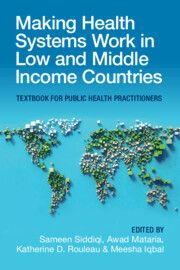 Making Health Systems Work in Low and Middle Income Countries
Making Health Systems Work in Low and Middle Income Countries Book contents
- Making Health Systems Work in Low and Middle Income Countries
- Reviews
- Making Health Systems Work in Low and Middle Income Countries
- Copyright page
- Dedication
- Contents
- About the Editors
- Contributors
- Preface
- Section 1 Analyzing Health Systems: Concepts, Components, Performance
- Chapter 1 Introduction to Health Systems
- Chapter 2 Health Systems Based on Primary Health Care
- Chapter 3 Universal Health Coverage and Health System Strengthening
- Chapter 4 Health System Governance
- Chapter 5 Financing Health Care
- Chapter 6 Health Workforce in Low and Middle Income Countries
- Chapter 7 The Pharmaceutical System and Its Components
- Chapter 8 Health Information Systems
- Chapter 9 The Organization and Management of Health Services
- Chapter 10 Health Services Delivery
- Chapter 11 Role and Contribution of the Community in Health System Strengthening
- Chapter 12 Performing Health Systems
- Chapter 13 Decision-Making Tools for Informed Decisions by Health Policymakers and Managers
- Chapter 14 Health Policy and Systems Research: The Role of Implementation Research
- Section 2 Transforming Health Systems: Confronting Challenges, Seizing Opportunities
- Index
- References
Chapter 6 - Health Workforce in Low and Middle Income Countries
Concepts and Dynamics Unpacked
from Section 1 - Analyzing Health Systems: Concepts, Components, Performance
Published online by Cambridge University Press: 08 December 2022
- Making Health Systems Work in Low and Middle Income Countries
- Reviews
- Making Health Systems Work in Low and Middle Income Countries
- Copyright page
- Dedication
- Contents
- About the Editors
- Contributors
- Preface
- Section 1 Analyzing Health Systems: Concepts, Components, Performance
- Chapter 1 Introduction to Health Systems
- Chapter 2 Health Systems Based on Primary Health Care
- Chapter 3 Universal Health Coverage and Health System Strengthening
- Chapter 4 Health System Governance
- Chapter 5 Financing Health Care
- Chapter 6 Health Workforce in Low and Middle Income Countries
- Chapter 7 The Pharmaceutical System and Its Components
- Chapter 8 Health Information Systems
- Chapter 9 The Organization and Management of Health Services
- Chapter 10 Health Services Delivery
- Chapter 11 Role and Contribution of the Community in Health System Strengthening
- Chapter 12 Performing Health Systems
- Chapter 13 Decision-Making Tools for Informed Decisions by Health Policymakers and Managers
- Chapter 14 Health Policy and Systems Research: The Role of Implementation Research
- Section 2 Transforming Health Systems: Confronting Challenges, Seizing Opportunities
- Index
- References
Summary
A well performing health workforce is critical for the success of any health system. A higher density of health workers vis-à-vis the population is associated with improved service coverage and health outcomes. This chapter highlights key considerations in identifying the critical health workforce challenges and the factors that influence them. It provides an overview of some of the conceptual underpinnings for a deeper understanding of the workforce issues, followed by a synopsis of specific low- and middle-income country (L&MIC) challenges and determinants related to workforce availability, distribution, and performance to improve service delivery and coverage goals. The desired health workforce should be able to effectively respond to the shifting health priorities of the population, given evolving disease burden and epidemiology, and deploy technological resources rationally and cost-effectively. This requires effectively matching the supply and skills of health workers to population needs, now and in the future.
Keywords
- Type
- Chapter
- Information
- Making Health Systems Work in Low and Middle Income CountriesTextbook for Public Health Practitioners, pp. 83 - 101Publisher: Cambridge University PressPrint publication year: 2022
References
- 1
- Cited by


